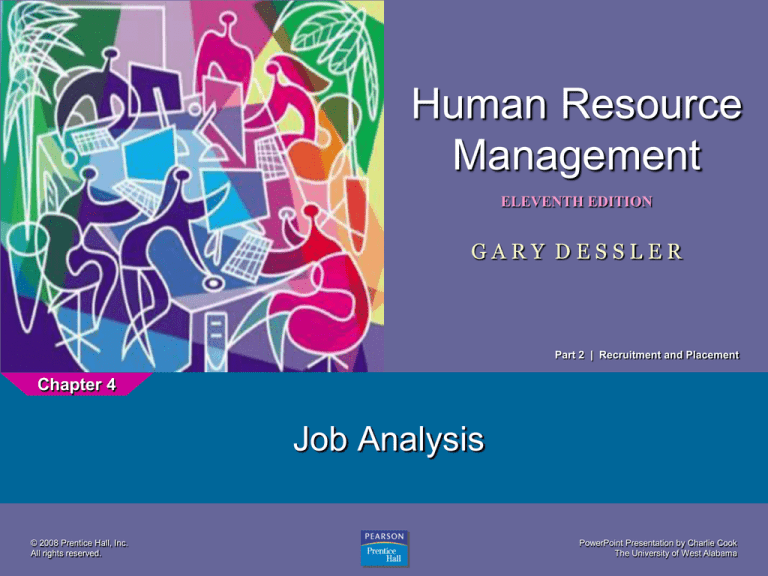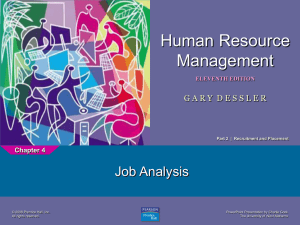
Human Resource
Management
ELEVENTH EDITION
1
GARY DESSLER
Part 2 | Recruitment and Placement
Chapter 4
Job Analysis
© 2008 Prentice Hall, Inc.
All rights reserved.
PowerPoint Presentation by Charlie Cook
The University of West Alabama
After studying this chapter, you should be able to:
1. Discuss the nature of job analysis, including what it is
and how it’s used.
2. Use at least three methods of collecting job analysis
information, including interviews, questionnaires, and
observation.
3. Write job descriptions, including summaries and job
functions, using the Internet and traditional methods.
4. Write job specifications using the Internet as well as
your judgment.
5. Explain job analysis in a “jobless” world, including
what it means and how it’s done in practice.
© 2008 Prentice Hall, Inc. All rights reserved.
4–2
The Basics of Job Analysis: Terms
• Job Analysis
The process for determining the jobs and skill
needed for a job and the kind of person who
should be hired for it.
• Job Description
•
A list of a job’s tasks, responsibilities, reporting
relationships, working conditions, and
supervisory responsibilities—one product of a
job analysis.
© 2008 Prentice Hall, Inc. All rights reserved.
4–3
• Job Specifications
A list of a job’s “human requirements,” that is, the
necessary education, skills, personality, and so
on—another product of a job analysis.
© 2008 Prentice Hall, Inc. All rights reserved.
4–4
Uses of Job Analysis Information
• Recruitment and Selection: Job analysis gives
necessary duties and desired human characteristics
information needed to effectively recruit and select
individuals for jobs.
• Compensation: factors such as skill and education level
safety hazards, degree of responsibility, and so on are
assessed by job analysis.
• Performance Appraisal: requires knowledge of the job’s
duties and standard to correctly do it.
© 2008 Prentice Hall, Inc. All rights reserved.
4–5
Methods of Collecting Job Analysis
Information: The Interview
• Information Sources
• Interview Formats
Individual employees
Structured (Checklist)
Groups of employees
Unstructured
Supervisors with
knowledge of the job
• Advantages
Quick, direct way to find
overlooked information
• Disadvantages
Distorted information
© 2008 Prentice Hall, Inc. All rights reserved.
4–6
Methods of Collecting Job Analysis
Information: Questionnaires
• Information Source
Have employees fill out
questionnaires to describe
their job-related duties and
responsibilities
• Questionnaire Formats
Structured checklists
Open-ended questions
© 2008 Prentice Hall, Inc. All rights reserved.
• Advantages
Quick and efficient way to
gather information from
large numbers of
employees
• Disadvantages
Expense and time
consumed in preparing
and testing the
questionnaire
4–7
Methods of Collecting Job Analysis
Information: Observation
• Information Source
Observing and noting the
physical activities of
employees as they go
about their jobs
• Advantages
Provides first-hand
information
Reduces distortion of
information
• Disadvantages
Time consuming
Difficulty in capturing
entire job cycle
Of little use if job involves
a high level of mental
activity
© 2008 Prentice Hall, Inc. All rights reserved.
4–8
Methods of Collecting Job Analysis
Information: Participant Diary/Logs
• Information Source
Workers keep a
chronological diary/ log of
what they do and the time
spent on each activity
• Advantages
Produces a more complete
picture of the job
Employee participation
• Disadvantages
Distortion of information
Depends upon employees
to accurately recall their
activities
© 2008 Prentice Hall, Inc. All rights reserved.
4–9
Internet-Based Job Analysis
• Advantages
• Collects information in a standardized format
from
• geographically dispersed employees
• Requires less time than face-to-face interviews
• Collects information with minimal intervention
or guidance
© 2008 Prentice Hall, Inc. All rights reserved.
4–10
The Job Description
• Job Identification
•
•
•
•
•
•
Job title
FLSA status section
Preparation date
Preparer
Location of the job
Salary and/or pay scale
•
•
•
• Job Summary
General nature of the job
Major functions/activities
© 2008 Prentice Hall, Inc. All rights reserved.
4–11
The Job Description
• Relationships
•
•
•
Reports to:
Supervises:
Works with:
•
Outside the company:
•
•
•
•
•
•
Responsibilities and Duties
Major responsibilities and
duties (essential functions)
Decision-making authority
Direct supervision
Budgetary limitations
© 2008 Prentice Hall, Inc. All rights reserved.
4–12
The Job Description
Standards of Performance and Working
Conditions
•
•
•
•
•
•
What it takes to do the job
successfully
Standards the employee is
expected to achieve under
each of the job description’s
main duties.
© 2008 Prentice Hall, Inc. All rights reserved.
4–13
Writing Job Descriptions
Job
Identification
Job
Summary
Job
Specifications
Sections of a
Typical Job
Description
Working
Conditions
Standards of
Performance
© 2008 Prentice Hall, Inc. All rights reserved.
Responsibilities
and Duties
Authority of the
Incumbent
4–14
Writing Job Specifications
“What traits and
experience are required
to do this job well?”
Specifications for
Trained Versus
Untrained
Personnel
© 2008 Prentice Hall, Inc. All rights reserved.
Specifications
Based on
Judgment
Specifications
Based on
Statistical
Analysis
4–15
KEY TERMS
job analysis
job description
job specifications
organization chart
process chart
diary/log
position analysis questionnaire
(PAQ)
functional job analysis
© 2008 Prentice Hall, Inc. All rights reserved.
job enlargement
job rotation
job enrichment
dejobbing
competencies
competency-based job analysis
performance management
4–16





